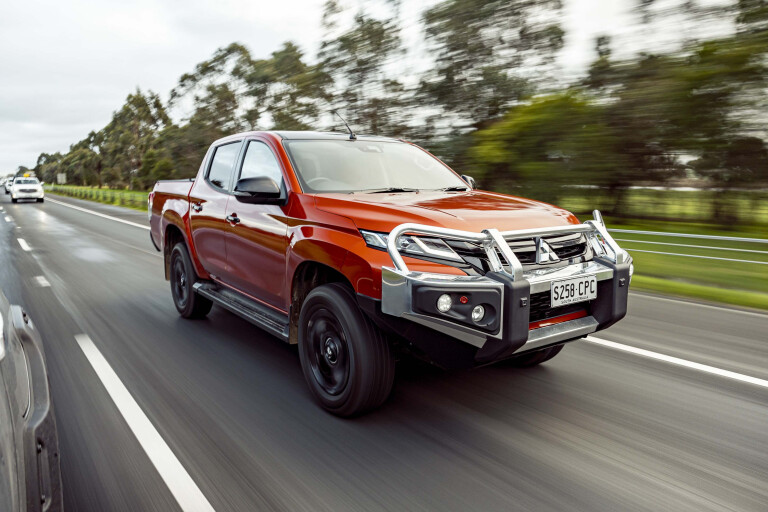
Score breakdown
Things we like
- Loaded with equipment
- Impressive off-road capability
- Industry-leading 10-year warranty
Not so much
- No stand-out attributes
- Firm, jiggly ride
- Roller tonneau hurts practicality
Utes have remained a mainstay of Australia’s motoring culture since their inception. First, as humble workhorses helping rebuild the nation after World War II, then morphing into V8 performance cars throughout the heat of the local post-2000s Red vs Blue era. Now, however, there are plenty of ute buyers who want more than a dusting of luxury SUV about their worksite wagon.
This is the need that Mitsubishi’s flagship Triton GSR aims to fill.
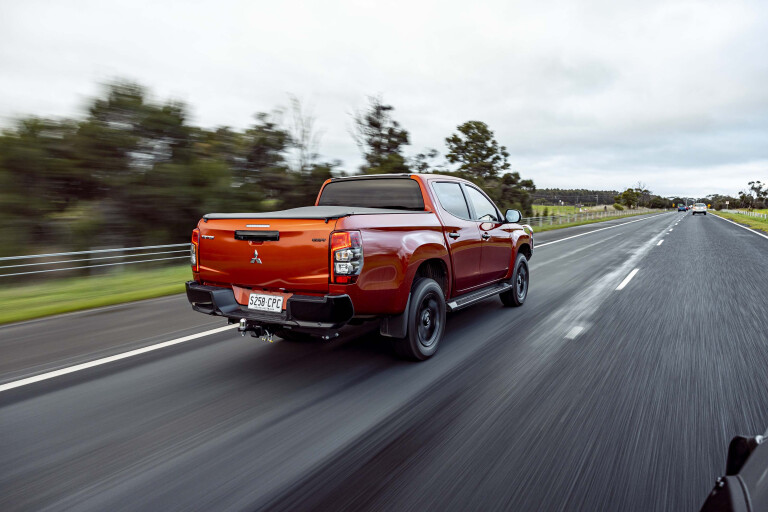
JUMP AHEAD
- How much is it, and what do you get?
- How do rivals compare on value?
- Interior, comfort, space and storage
- What’s the payload and is the tray practical?
- What is it like to drive?
- How is it on fuel?
- Is it good for towing?
- How safe is it?
- Warranty and running costs
- VERDICT
- Specifications
Resplendent in eye-catching (and no-cost optionable) Sunflare Orange paint, our Triton GSR test vehicle is rocking a shiny steel bullbar ($4611) to go with the standard tan orange leather-appointed upholstery (with heated front seats), keyless entry, a 7.0-inch infotainment screen with digital radio, smartphone mirroring and more.
Considering the top-shelf Triton opens with a list price of $55,690 (before on-road costs), that’s a generous equipment list for the money. It undercuts the new four-pot Ford Ranger Wildtrak’s list price by $10,500 and the Toyota HiLux SR5 4x4 by $6240.

Of course, with a new-generation Triton waiting in the wings and due in 2023, the familiar Triton is beginning to show its age in the face of younger competition.
It’s well-equipped and trades high on its strong value proposition, but faults are beginning to show in its driving dynamics. The current generation was facelifted in 2019 but has spent seven years on the Australian market now.
How does the top-spec Triton stack up in today’s hotly contested dual-cab ute segment? Let’s find out.
How much is it, and what do you get?
Mitsubishi's most recently updated MY22.5 Triton pricing announced back in April pitches the GSR dual-cab at $56,690 before on-road costs.
This update includes improved infotainment with the inclusion of Mitsubishi’s Smartphone link Display Audio system (with improved Apple CarPlay and Android Auto functionality), and adds a 360-degree camera system, for a modest increase of $2450.
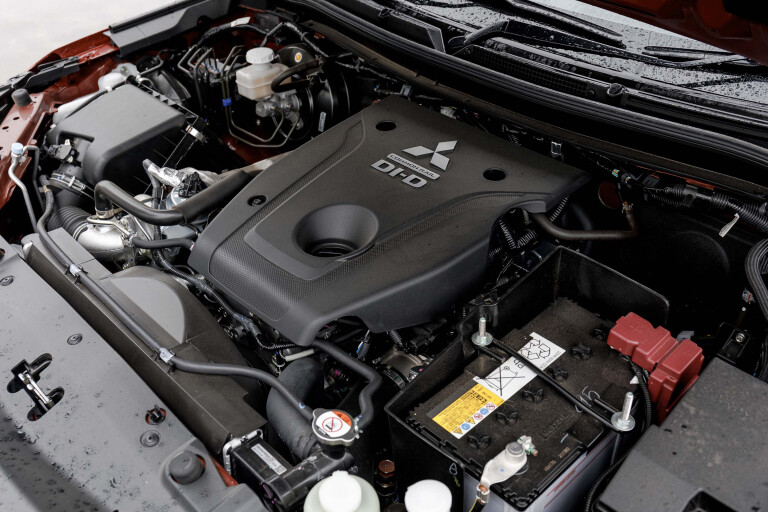
Long-time Mitsubishi enthusiasts will recognise the GSR nomenclature from sporty Lancers of yore, preceding the hallowed Evo nameplate. Here, though, the Triton GSR uses the same 2.4-litre turbo-diesel and six-speed automatic powertrain configuration as the rest of the range, producing 133kW/430Nm.
Visually distinguishing the GSR is the blacked-out trim with matching grille, roof, mirrors, door handles and sports bar.
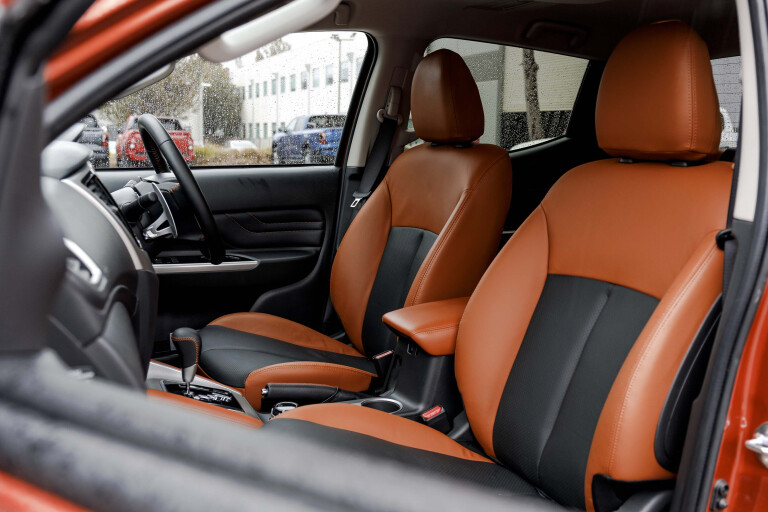
Tech, comfort and convenience features include keyless entry, tan orange leather seats with heated front row and powered driver’s side adjustment, a six-speaker stereo, 7.0-inch infotainment screen, dual-zone climate control, front and rear parking sensors, automatic wipers and headlights, improved Apple CarPlay and Android Auto functionality, 360-degree camera and more.
A feature of upper-spec Tritons is Mitsubishi’s Super Select four-wheel-drive system with the ability to switch between rear-wheel, all-wheel and locked four-wheel drive modes on the fly, with high- and low-range gearing plus a locking rear differential.
Standard-fit safety equipment comprises front, front-side, curtain and driver’s knee airbags, plus autonomous emergency braking (AEB), lane departure warning, blind-spot monitoring and trailer stability assist.
How do rivals compare on value?
Mitsubishi’s Triton trades on value and undercuts up-spec aforementioned Ranger and HiLux rivals.
In the case of the popular HiLux SR5 4x4 automatic, the Triton GSR saves $6240 and contains many of the same popular features as standard.
Both SR5 and GSR features are quite similar, though Triton owners may miss the more modern cabin of the HiLux, as well as technologies such as speed sign recognition and adaptive cruise control. The Toyota's bigger 2.8-litre turbo-diesel is also punchier, with outputs of 150kW and 500Nm.
Interior, comfort, space and storage
Stepping into the cabin, great strides have been made to lift the visual ambience of this traditionally blue-collar ute.
The tan orange upholstery is certainly eye-catching, and the leather-covered steering wheel, gear selector and door trims are welcome added niceties to your main touchpoints with the vehicle.
Function still leads form, which isn’t necessarily a bad thing, however, with much hard plastic to be found on the dashboard and a switchgear layout that, while intuitive, ergonomic and functional, is beginning to look a little dated in the face of younger rivals.
There’s decent levels of adjustability for a variety of driver builds, with a tilt- and reach-adjustable steering column plus powered driver’s seat controls. The front seats are mounted high, but feel solid and supportive.

Although functional and responsive, the 7.0-inch touchscreen is smaller than those found in competitors.
Two central cup holders, a bin under the armrest and large bottle-sized bins in each door provide easy storage solutions close to hand. Two USB-A plugs up front provide smartphone mirroring and charging, and there’s an HDMI input up front, too.
Second-row seats look a bit thin and basic but are deceptively supportive once you sit in them, with a fair bit of rake to the backrests and surprisingly good under-thigh support in comparison to rivals with much flatter seats.
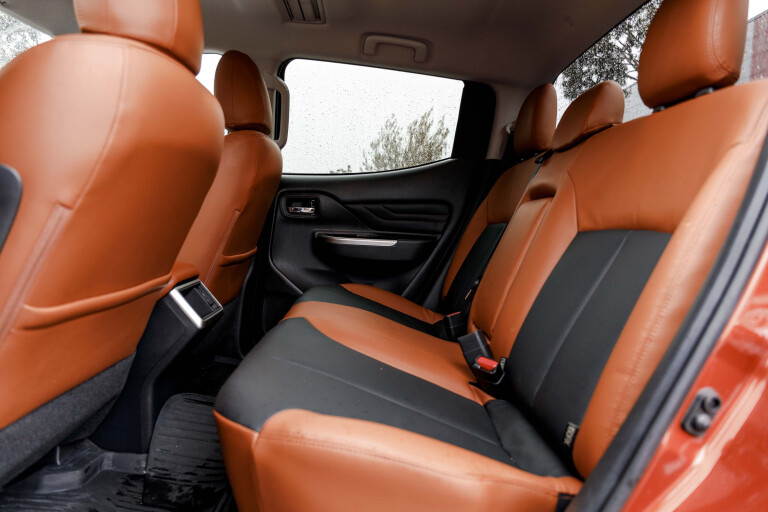
The softer leather seat trim is a welcome luxury over the cloth upholstery found in lower-spec Tritons. Middle seat legroom, however, is impinged by a little storage tray that pokes out behind the front armrest and a rather tall transmission tunnel.
At 175cm tall, I fit with relative comfort in the second-row outboard seats, with some legroom and toe room to spare. It’s not a wide cabin though, and even with a small child in the middle seat, seating three abreast would quickly become quite cosy.
There are two further USB ports to be found back there, plus two cup holders in the fold-down centre armrest along with large door pockets for rear passengers.
What’s the payload and is the tray practical?
Triton dual-cab trays measure 1520mm in length, 1470mm in width and 175mm in height – with 1085mm at the narrow point between the wheel wells.
It must be noted that an available lockable roller cover, while handy for security, does impinge on tray space and shifts the tie-down points rearward.
Payload capacity is 901kg, which is down 44kg on the cheaper, more workhorse-oriented GLX+.

What is it like to drive?
The basics
| 2023 Mitsubishi Triton GSR specifications | |
|---|---|
| Drive | selectable four-wheel |
| Engine | 2442cc 4-cylinder turbo diesel |
| Transmission | 6-speed automatic |
| Power & torque | 133kW @ 3500rpm / 430Nm @ 2500rpm |
| Weight | 1999kg (kerb) |
| Suspension | double A-arm, coil springs, anti-roll (front); leaf spring (rear) |
| Price | $55,690 + on-road costs |
Mitsubishi’s Triton trades well on its value-minded asking price and generous levels of included equipment, but it falls short of class benchmarks due to ageing driving dynamics.
It’s a competent machine, especially so when you consider its native ability off-road, but falters in the finer points of on-road ride and handling.
Like many vehicles of this class, the steering ratio is rather slow, producing lots of arm movements when navigating tight urban areas at low speeds. There’s also a bit of an on-centre dead zone, needing a touch more steering input than you might expect before the front end begins to react.
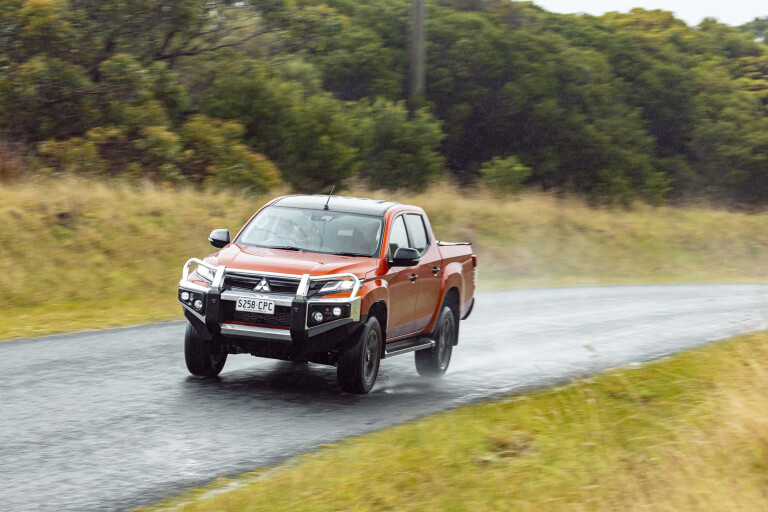
The 2.4-litre four-cylinder turbo-diesel is effective but quite vocal and lacks the smooth refinement of younger rivals. There’s decent torque to be found low down, however, and it’s a smooth sailer once up to a cruise, calmly building pace as the six-speed automatic keeps the powerplant within its comparatively narrow operating window.
In fact, the automatic six-speed transmission’s logic feels rather well-matched to the engine, as I rarely felt the need to take charge of shifts of my own (though the aluminium paddle shifters, lifted from the now-extinct Mitsubishi Lancer Evolution X, did make me giggle).
Despite the novelty, there is a noticeable pause between engaging the paddle shifters and the transmission reacting with a gear change, so it’s often quicker to let the automatic work it out for itself.
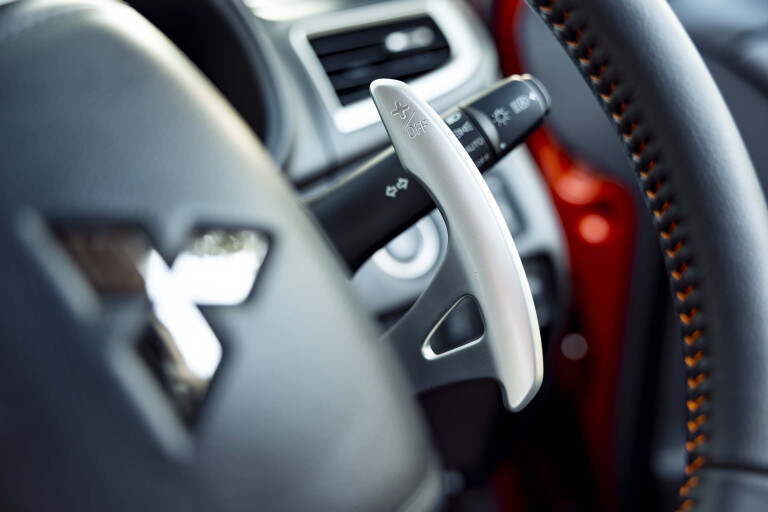
Away from the tarmac at lower speeds, body control is above par, but on-road the ride is terse and firm with a quick rebound effect that often has the body unsettled by even small bumps.
In fact, on thin road corrugations, there’s an unsettling see-saw effect with vibrations transmitted throughout the body structure.
This is a competent machine overall but falls short on the finer points of ride and refinement in comparison to rapidly developing challengers and rivals that have appeared on the market within the last five years.

How is it on fuel?
The 2023 Mitsubishi Triton GSR wears a manufacturer-claimed fuel consumption figure of 8.6L/100km.
Previous testing, however, during the Wheels 2022 dual-cab comparison, showed the top-spec Triton returning 10.6L/100km in the real world, covering 235km on our test loop and drinking 25.01L of fuel.
Total fuel tank capacity of the Mitsubishi Triton is 75 litres.
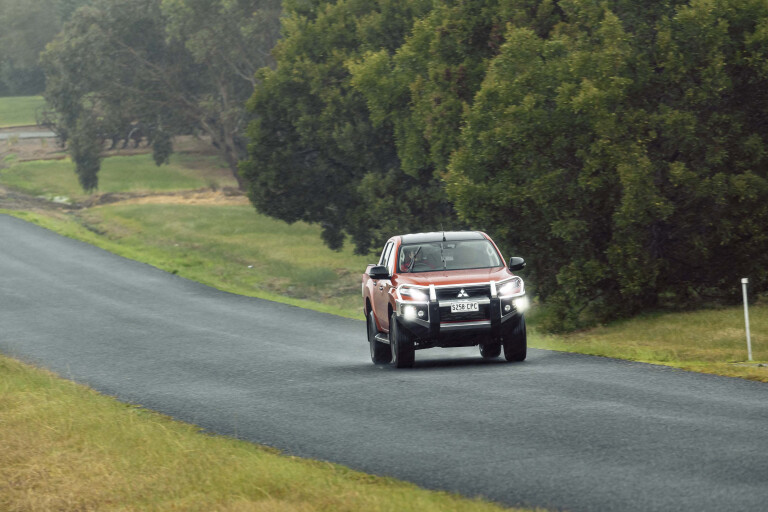
Is it good for towing?
The Triton is physically smaller than many of its competitors and for many buyers, this is a positive. But its size and relatively short wheelbase of 3000mm means that Mitsubishi conservatively rates the Triton's towing limit to 3100kg.
However, it does make up for this shortcoming somewhat with a generous GCM that still allows you to carry a bit in the vehicle if you are towing at the maximum weight.
Also beneficial on the Mitsubishi are the transmission paddle shifters mounted behind the steering wheel that make it easy to tip back a gear or two when you want a bit of engine braking.
But there’s a lot of leverage between the tow bar and the rear axle, resulting in porpoising when travelling over uneven road surfaces and that short wheelbase combines with a long overhang at the rear to give the Triton a bouncy feel when towing a 2100kg Jayco caravan.

How safe is it?
All 2023 Mitsubishi Tritons bear an ANCAP rating of five out of five stars.
It achieved this during initial testing in 2015, with the pre-facelift range, so would be unlikely to achieve a top score if tested against today's tougher criteria.
Standard features include autonomous emergency braking with pedestrian and cyclist detection and junction assist (when turning across oncoming traffic), blind-spot monitoring, rear cross-traffic alert and lane departure warning (but no lane-centring assistance).
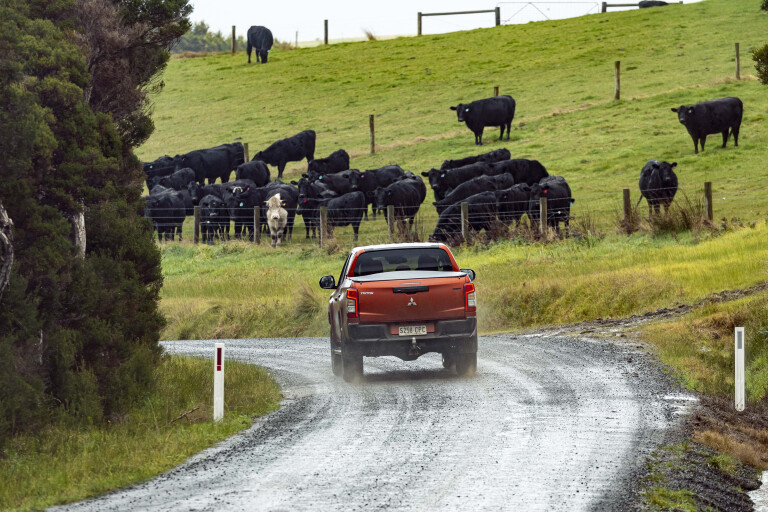
Warranty and running costs
All new Mitsubishis are covered as standard by a five-year/100,000km vehicle warranty. Stay on top of your scheduled servicing with the Mitsubishi network, however, and Mitsubishi will extend your warranty to an impressive ten years or 200,000km.
Servicing intervals are every 120 months or 15,000km, whichever comes first.
Mitsubishi will also cap servicing costs for the first ten years or 150,000km, with subsequent maintenance costs projected at around $600 per year (or every 15,000km).
VERDICT
The Triton GSR occupies a particular in-between spot among the major players within the bursting dual-cab ute market. It’s a decent way cheaper than the popularly desired heavy hitters and presents impressively for the money you pay.
It doesn’t boast the on-road driving finesse or the engine refinement of the new Ranger, but it's a viable and more affordable alternative for those who lie awake at night thinking about the ever-popular HiLux.
If you do hard and dirty work, the Triton’s rugged but basic interior will perhaps suit your life even better, with greater peace of mind from Mitsubishi’s superior warranty.

2023 Mitsubishi Triton specifications
| Body | 4-door, 5-seat dual-cab ute |
|---|---|
| Drive | selectable four-wheel |
| Engine | 2442cc 4-cylinder turbo diesel |
| Transmission | 6-speed automatic |
| Power | 133kW @ 3500rpm |
| Torque | 430Nm @ 2500 |
| Bore stroke (mm) | 86 x 105 |
| Compression ratio | 15.5 : 1.0 |
| 0-100km/h | 11 seconds (estimated) |
| Weight | 1999kg (kerb) |
| Suspension | double A-arm, coil springs, anti-roll (front); leaf spring (rear) |
| L/W/H | 5305/1815/1795mm |
| Wheelbase | 3000mm |
| Brakes | 320mm ventilated discs (front); 285mm solid discs (rear) |
| Tyres | 265/60 R18 Bridgestone Dueler H/T |
| Wheels | 18-inch alloys |
| Price | $55,690 + on-road costs |
Score breakdown
Things we like
- Loaded with equipment
- Impressive off-road capability
- Industry-leading 10-year warranty
Not so much
- No stand-out attributes
- Firm, jiggly ride
- Roller tonneau hurts practicality


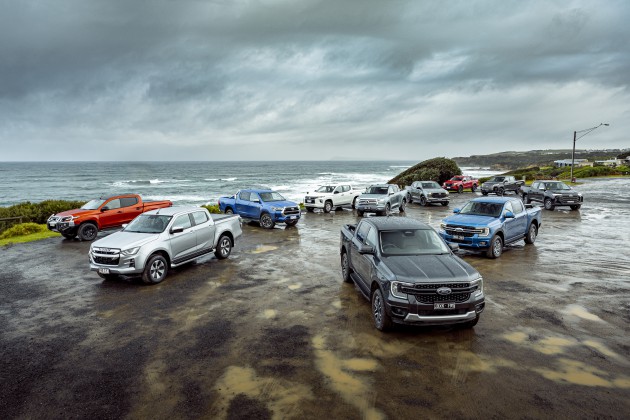

COMMENTS